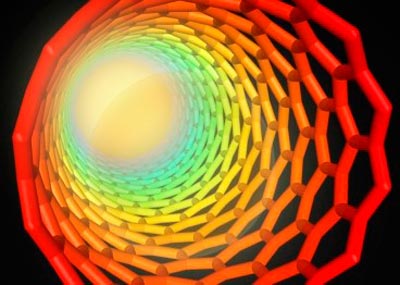
Researchers in the US and Korea have discovered that igniting a carbon nanotube, coated in chemically flammable material, can trigger a high-speed wave to race along the tube at 10,000× the speed of the spreading chemical reaction. The new phenomenon, dubbed a “thermopower wave”, could lead to a new way of generating electricity and may enable micro power sources to drive nanoscale devices.
These self-propagating waves, which are related to combustion waves, had previously been predicted by the same researchers in earlier papers. “This research is doubly satisfying as, usually, in nanotechnology nature is one step ahead of us and our experiments force us to rework our equations,” says Michael Strano, one of the researchers at the Massachusetts Institute of Technology.
In their experiment, Strano and his colleagues coated multi-walled nanotubes (MWNTs) – which consist of multiple rolled layers sheets of graphene – with a chemical fuel known as cyclotrimethylene trinitramine (CNT). They then fire the system with a low-power laser, which ignites the fuel to initiate a reaction in the chemical, which spreads along the nanotube. However, the burning fuel also triggers a thermopower wave, which also starts to propagate along the nanotube at 1–10 metres each second – 104× faster than the reaction itself.
Shunting electrons
The new phenomenon gets its name from the fact that high speed thermal waves energize electrons before, effectively, “pushing” them through the nanotube – establishing an electric current. It is observed here in carbon nanotubes because the low heat capacity enables a feedback system where heat escaping from the nanotube ignites more fuel and increases the speed of chemical reaction. The resulting electrical pulses can lead to a specific power as high as 7 kW/kg, which is 10× the same value associated with standard lithium batteries.
That high power density could allow such materials to be used as environmentally friendly storage devices that avoid the toxic substances, such as lithium, cadmium and lead.
“The high energy density demonstrated is especially exciting, which may revolutionize the energy storage technology,” agrees Yu-Ming Lin, a nanotechnology researcher at the IBM T J Watson Research Center in New York.
However, Strano and his team want to focus their efforts in the short term on characterizing the phenomenon in more detail. They realize that many engineering challenges will need to be overcome for designing devices for specific applications, especially in finding a way to keep heat within energy storage devices. In the long term, however, Strano says that he is interested in pursuing partnerships with industry.
Higher dimensions
Strano, who is a chemical engineer by training, says that his mathematical modelling also predicts a 2D form of these thermopower waves. Indeed, if he proves to be correct, this finding could enable engineers to start exploring applications with a much wider range of materials. This may even include the “wonder material”, graphene, consisting of single sheets of carbon just one atom thick, which has excited engineers since its discovery in 2004 on account of its unique mechanical and electrical properties.
Alexander Balandin, a materials scientist at the University of California-Riverside, agrees that it would be exciting to observe this phenomenon in 2D. “Graphene, as a planar system, may have advantages in certain applications. In essence, nanotubes and graphene seem to be complementary to each other in terms of applications”.
This research is published in Nature Materials.



